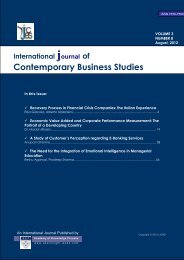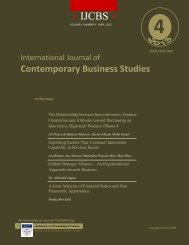International journal of Contemporary Business Studies
International journal of Contemporary Business Studies
International journal of Contemporary Business Studies
Create successful ePaper yourself
Turn your PDF publications into a flip-book with our unique Google optimized e-Paper software.
<strong>International</strong> Journal <strong>of</strong> <strong>Contemporary</strong> <strong>Business</strong> <strong>Studies</strong><br />
Vol: 3, No: 6. June, 2012 ISSN 2156-7506<br />
Available online at http://www.akpinsight.webs.com<br />
The first factor (PB1) can be interpreted as the dimension <strong>of</strong> "influence", it consists <strong>of</strong> items (see<br />
appendix B) 3, 4 and 5 (Milani, 1975; Hassel & Cunningham, 1993, 1996) explains 54, 73% <strong>of</strong><br />
the total variance. This factor has a Cronbach α value <strong>of</strong> 0.803.<br />
The second factor (PB2) is the “involvement” (items 1, 2 and 6) which explains 16, 66% <strong>of</strong> the<br />
total variance. The reliability coefficient <strong>of</strong> this factor is 0.771.<br />
3.2.3. The moderator variable "intensity <strong>of</strong> market competition (COMP)<br />
The measurement <strong>of</strong> this variable was originally made by Khandwalla (1972). However, several<br />
criticisms and shortcomings have been addressed to this measure.Mia & Clarke (1999) propose<br />
an alternative measure into six items describing the state <strong>of</strong> competitiveness <strong>of</strong> the company<br />
(Appendix C); the answers are spread on a Likert scale <strong>of</strong> five points ranging from 1 (very poor)<br />
to 5 (very strong).<br />
For the internal validity <strong>of</strong> the construct, the reliability coefficient is 0.451, it is less than 0.6. So,<br />
all items constituting the scale <strong>of</strong> measurement is not reliable. It is advisable to proceed with a<br />
measure <strong>of</strong> adequacy <strong>of</strong> sampling and factor analysis to find the items or responsible for this<br />
anomaly.<br />
The study <strong>of</strong> the scale dimensionality <strong>of</strong> this variable showed that the measure <strong>of</strong> sampling<br />
adequacy <strong>of</strong> KMO was 0.426. This value is low, which indicates the absence <strong>of</strong> the<br />
unidimensionality <strong>of</strong> instrument.<br />
Table 5. Factor analysis for Intensity <strong>of</strong> Market competitiveness<br />
Factor Loading a<br />
Items First factor Second factor Third factor<br />
COMP1 b 0,741<br />
COMP2 0,860<br />
COMP3 0,718<br />
COMP4 0,809<br />
COMP5 0,884<br />
COMP6 0,617 0,549<br />
Extraction Method: Principal Components Analysis<br />
Rotation Method: Varimax with Kaiser Normalization<br />
Three dimensions are extracted<br />
Cronbach Reliability coefficient = 0.451<br />
a Values below 0.5 are eliminated<br />
b<br />
COMP1, …, COMP6 are the items measuring the intensity <strong>of</strong> market competitiveness<br />
The results <strong>of</strong> the rotation axis factor analysis showed that the items are divided into three<br />
factors. The inverse matrix and anti-image correlation matrix enabled us to retain the factor<br />
composed by the following items: 1, 3 and 4 (Competitive Price, Competitive Marketing,<br />
Competitiveness market share).<br />
Copyright © 2012. Academy <strong>of</strong> Knowledge Process<br />
43
















